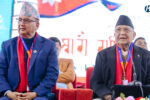Last week saw a mix of developments in Nepal’s economic landscape, highlighted by a notable recovery in gold prices, which surged by Rs 7,200 per tola, driven by strong demand, while silver prices showed modest gains.
However, the Nepal Stock Exchange (NEPSE) faced a 2.49% decline, signaling ongoing market volatility.
Despite the broader market challenges, positive steps were seen in other sectors, with SEBON facilitating investment by Non-Resident Nepalis in the stock market and Nepal’s foreign trade showing growth, although the trade deficit continued to widen.
Significant progress was made in the energy sector, with the Sanjen Hydropower Project coming online and the 135 MW Manang Marsyangdi Hydropower Project advancing.
Additionally, preparations for the Mundhum Trail Visit Year 2025 and Miteri Development Bank’s proposal for a 10% dividend further demonstrated a commitment to boosting tourism and investor confidence.
Meanwhile, Elon Musk’s interest in expanding Starlink services to Nepal represents a promising step towards improving connectivity, particularly in remote areas, adding another dimension to the country’s growing infrastructure and economic development.
Gold prices surge last week, silver shows modest gains
In the week ending November 24, 2024, gold prices in Nepal showed a consistent upward trend, marking a significant recovery from the previous month’s decline.
Starting from Rs 160,000 per tola on November 18, gold prices increased steadily, reaching Rs 167,200 per tola by November 24, a total rise of Rs 7,200 over the week.
This surge came after a drop in October, when gold had fallen by Rs 11,000 from its all-time high of Rs 171,000 per tola.
The rise in gold prices last week was gradual, with daily increments of Rs 1,000 to Rs 2,000, reflecting strong market demand. The price of silver, in contrast, showed more fluctuations.
After rising early in the week, silver prices eventually stabilized, though they did see a slight increase by November 24, reaching Rs 1,960 per tola, up by Rs 15 compared to the previous Friday.
Overall, the week saw gold prices recover significantly, while silver remained somewhat more volatile, with prices influenced by various domestic and international factors.
The continuous rise in gold prices suggests a renewed investor confidence, possibly due to global economic shifts or domestic market conditions driving the demand for precious metals.
NEPSE ends the week with 2.49 percent loss
The Nepal Stock Exchange (NEPSE) concluded the week ending November 22 with a decline of 2.49 percent, closing at 2,680.44 points, down 68.34 points from the previous week’s close of 2,748.78.
The market traded for four days, with Monday being a public holiday. Despite hitting a high of 2,788.12 and a low of 2,676.25, the NEPSE Index witnessed volatility of 111.87 points, slightly higher than the previous week’s range of 107.65 points.
This week, total turnover amounted to Rs 37.54 billion, with a daily high of Rs 10.46 billion on Tuesday, which saw the highest intraday loss of 51.11 points.
Over 8.09 crore units of shares were traded through 378,240 transactions, bringing the market capitalization to Rs 4.26 trillion.
The market showed mixed technical indicators. The Relative Strength Index (RSI) reading on the daily timeframe stood at 48.51, signaling a neutral market sentiment, while the weekly RSI was at 57.45, indicating slightly stronger bullish momentum.
On the other hand, the MACD and Signal lines remained in the positive zone, suggesting a potential for upward movement.
However, with the NEPSE Index trading below both the 20-day and 5-day Exponential Moving Averages, the market sentiment leaned bearish.
The 2,600 level is seen as the nearest support, while the 2,860 level remains a key resistance.
In terms of sector performance, the market saw varying results, with some sectors facing pressure while others showed resilience despite the overall downturn.
The decline this week reflects broader market corrections following a modest recovery last week, and investors are likely to remain cautious with volatility continuing to shape market movements.
SEBON opens door for NRNs to invest in Nepal’s stock market
In a significant move, the Securities Board of Nepal (SEBON) has paved the way for Non-Resident Nepalis (NRNs) to invest in Nepal’s secondary market through the amendment of its Securities Issuance and Distribution Directive 2024.
The amendment allows NRNs to invest in the stock market by establishing joint investment companies, which can issue up to 49% of their shares to NRNs.
However, there are several conditions attached, including the requirement that these companies be registered with SEBON before issuing Initial Public Offerings (IPOs).
The IPOs can only be offered to NRNs for a period between four and 15 days, and these shares can only be traded among NRNs for one year.
SEBON’s move aims to attract more capital from NRNs to the domestic market, potentially boosting investment and liquidity in Nepal’s stock exchange, while keeping the trading within the NRN community.
This initiative is expected to have long-term positive impacts on Nepal’s capital market, helping it mobilize more resources from the growing NRN population.
Nepal’s foreign trade shows modest growth; trade deficit widens
Nepal’s foreign trade showed positive growth in the fourth month of the fiscal year, with exports increasing by 4.16% to Rs 52.67 billion and imports rising slightly by 0.17% to Rs 513.38 billion.
However, the trade deficit continued to widen, reaching Rs 460.71 billion by mid-November, a slight increase from mid-October.
Despite the growth in exports, imports outpaced exports, particularly in sectors like electric vehicles (EVs) and mobile phones.
EV imports surged by 26%, reflecting growing interest in sustainable transport, while mobile phone imports also saw high volumes, with China being the main supplier.
While the recovery in trade is positive, the rising deficit highlights the ongoing challenge of balancing Nepal’s trade, especially with high demand for foreign goods.
Sanjen Hydropower Project begins supplying power to Nepal’s national grid
In a significant development for Nepal’s energy sector, the Sanjen Hydropower Project successfully connected its first unit of 5 megawatts to the national grid on Friday evening, marking the beginning of power generation from the 42.5 MW project located in Rasuwa.
After completing all necessary technical tests, the project’s first unit began supplying electricity, with preparations underway to connect the remaining two units.
The project is being hailed as a model semi-reservoir hydropower initiative, featuring a “peaking pond” that can store 44,000 cubic meters of water.
This innovation will allow for additional power generation during evening peak hours and provide backup in case of system failures.
With the completion of this project, Nepal is set to enhance its energy capacity and improve grid reliability, contributing to its growing efforts to meet the rising electricity demand.
Financial closure achieved for 135 MW Manang Marsyangdi Hydropower Project
The successful financial closure of the 135 MW Manang Marsyangdi Hydropower Project (MMHP) marks a significant milestone for Nepal’s energy sector. On Friday, Manang Marsyangdi Hydropower Company Pvt. Ltd.
(MMHCPL) secured a loan agreement with EXIM Bank, China, amounting to CNY 1.24 billion (approximately USD 175 million), part of the total project cost of USD 323 million.
The remaining financing has been arranged through other sources. The project, located in Manang, is being developed under a joint venture that includes Nepal’s Butwal Power Company (BPC) and Chinese investors.
The financing structure will have an 80:20 debt-equity ratio, with BPC holding a 20% equity stake.
Construction of the project, which will be undertaken by Sinohydro Bureau 7 Co. Ltd. under the EPC model, is expected to be completed within 42 months.
The project aims to generate 766 GWh of energy annually and will feature a 6 km long headrace tunnel, a dam on the Marsyangdi River, and a powerhouse in Nasong Rural Municipality.
The MMHP is the first of three hydropower projects being developed in the region under a cascade modality, with a combined capacity of 601 MW and an estimated total cost of USD 1.2 billion.
This development, along with the other planned projects, will significantly enhance Nepal’s power generation capacity, contributing to the country’s energy security and economic growth.
Preparations underway for Mundhum Trail Visit Year 2025
Preparations are in full swing for the launch of the Mundhum Trail Visit Year 2025, set to begin on January 1, with the ambitious goal of attracting 100,000 visitors throughout the year.
The campaign, led by the Maiyung-Temke-Salpa-Silingchung Tourism Promotion Center, aims to promote the newly explored Mundhum Trail, which stretches across the districts of Bhojpur, Khotang, Solukhumbu, and Sankhuwasabha.
Described as a “virgin destination” by the Center’s President Ramesh Rai, the trail offers stunning views of iconic mountains like Sagarmatha (Mount Everest) and Kanchenjunga, making it an appealing off-the-beaten-path option for trekkers.
To support the influx of visitors, the center is enhancing infrastructure along the trail, including installing drinking water facilities, rest stops, toilets, and expanding accommodation options such as homestays and guesthouses.
If successful, the campaign will not only boost tourism in the region but also help highlight the potential of lesser-known trekking routes in Nepal’s diverse landscape.
Minister Pandey’s commitment to sustaining GBIA’s role
Minister Badri Prasad Pandey’s assurance regarding the continued operation of Gautam Buddha International Airport (GBIA) highlights the government’s dedication to strengthening Nepal’s tourism and aviation sectors, even as Tribhuvan International Airport (TIA) undergoes runway expansion.
Pandey addressed concerns from local businesses about the potential decline in international traffic to GBIA once TIA resumes regular operations post-expansion.
His emphasis on GBIA’s strategic location, particularly its proximity to Lumbini, the birthplace of Buddha, underscores its significance as a vital gateway for international visitors.
By committing to monitor GBIA’s operations twice a month and considering the establishment of a liaison office in Bhairahawa, Pandey signals a proactive approach to ensure the airport’s sustainable growth.
Furthermore, the planned establishment of key offices related to labor, visas, and medical services is a positive step toward creating a more efficient and attractive environment for travelers and businesses alike.
As Bhairahawa continues to gain prominence as a tourism hub, the Minister’s initiative to secure GBIA’s place as a central pillar of Nepal’s aviation infrastructure is likely to bolster both regional economic development and the broader tourism sector, especially with the increasing focus on Lumbini as a global tourist destination.
Miteri Development Bank’s proposed 10% dividend for FY 2080/81
Miteri Development Bank’s proposal of a 10.0083% dividend for the fiscal year 2080/81 reflects a strong performance and a commitment to rewarding its shareholders.
The dividend, which is based on a paid-up capital of Rs. 1.11 Arba, includes both bonus shares (9.5079%) worth Rs. 10.56 crores and a cash dividend (0.5004%) of Rs. 55.61 lakhs, signaling the bank’s financial health and shareholder-friendly approach.
The proposed dividend, pending approval from Nepal Rastra Bank and the upcoming AGM, is a positive development that could enhance investor confidence.
The decision to allocate a significant portion of the dividend as bonus shares also indicates that the bank is focusing on long-term growth, reinvesting in its capital base rather than distributing all profits in cash.
Overall, this move highlights MDB’s solid growth trajectory and its intention to maintain a balanced approach between rewarding shareholders and ensuring financial stability for future expansion.
Elon Musk’s interest in expanding Starlink to Nepal
Elon Musk’s expressed interest in expanding Starlink’s services to Nepal marks a significant step for the country’s telecommunication sector.
During a virtual meeting with Prime Minister K P Sharma Oli last week, Musk discussed his plans for Starlink, a satellite-based internet service that could enhance connectivity in Nepal, especially in remote and underserved areas. Starlink’s expansion into Nepal is a promising prospect for improving internet access, potentially revolutionizing communication infrastructure in rural regions.
While PM Oli acknowledged the proposal, he emphasized the need for further study and consultation before moving forward.
The invitation for Musk to visit Nepal highlights the government’s cautious approach while also signaling openness to innovative solutions for expanding digital connectivity.
If realized, Starlink’s presence could play a crucial role in bridging the digital divide in Nepal, particularly in areas with limited access to traditional broadband services.
(Prepared by Srija Khanal)









Comment